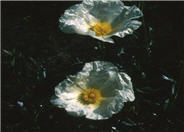
Common name:Palhinae Rockrose
Botanical name:Cistus ladanifer latifolius
The palhinae variety produces long, pointed leaves and large white flowers with a small crimson spot. Its narrow leaves, rounded at the tips, are well-covered with a beautiful shiny, sticky resin, appearing "varnished." The plant requires average to good drainage, and little or no summer watering when established. It should be grown in sun or part shade.
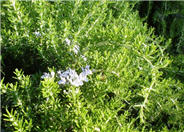
Common name:Rosemary
Botanical name:Rosmarinus officinalis
Rosemary is hardy in full sun areas where winter temperatures do not drop below 10 degrees F. They can be grown in a clay pot with well-drained, porous soil in bright indoor light, and will also flourish on the backporch in spring, summer and fall. Its beautiful, slowly trailing stems and shiny slender leaves are perfect for showing off the small, light blue flowers that blossom in the summer.
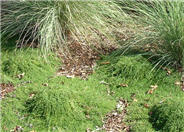
Common name:Elfin Creeping Thyme
Botanical name:Thymus praecox arcticus 'Elfin'
This 2" perennial groundcover is a great addition among other sun-loving perennials. Its creeping stems bear small purple flowers all summer. The plant spreads quickly, and should be placed in average to moist garden soil. The thyme-scented foliage can be used to flavor food.
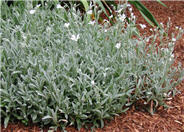
Common name:Snow-In-Summer
Botanical name:Cerastium tomentosum
Masses of snow white flowers highlight this plant during the early summer season.
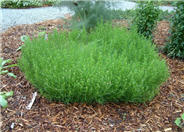
Common name:Green Lavender Cotton
Botanical name:Santolina rosmarinifolia
Santolina is an amazingly tough plant with small, yellow, button-sized flowers that cover the 3' tall and 3' wide shrub in the summer months. The green leaves are very thin and needle like. This plant requires absolutely no care in most environments once established. Too much water will lead to mortality. Best grown in well drained soils.
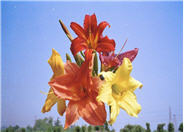
Common name:Hybrid Daylily (various)
Botanical name:Hemerocallis hybrids
These summer-blooming perennials form clumps with large, grass-like leaves. Its showy flowers, resembling lilies, are borne in clusters on stems held well above the foliage
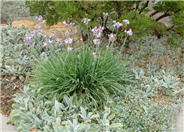
Common name:Society Garlic
Botanical name:Tulbaghia violacea
This clumping perennial will grow less than 1' tall and has narrow, blue green leaves. Clusters of lavender flowers bloom in spring and summer. Leaves and flowers have a distinct onion or garlic smell if crushed.
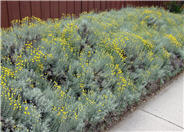
Common name:Lavender Cotton
Botanical name:Santolina chamaecyparissus
This ground cover/small shrub will grow to 3' tall and has small, grayish silver leaves with yellow flowers that bloom in the summer.
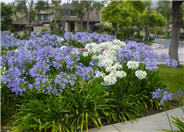
Common name:Lily of the Nile
Botanical name:Agapanthus hybrids
This evergreen ground cover/shrub will grow about 3' tall and has large green leaves with blue flowers (there is a white variety and dwarf varieties) that bloom in spring and summer. It will grow in all soils but prefers loam soil.
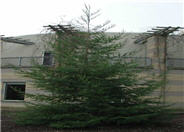
Common name:Coast Redwood
Botanical name:Sequoia sempervirens
This fast growing, aromatic tree has soft, dark green foliage with long needles appearing in flat sprays and brown, barrel-shaped cones that appear after 1 year. Its soft, red-brown bark is fiberous and furrowed. Particularly after mechanical damage, this tree will stump sprout to form new, young trees around the stump. Avoid planting in areas of high foot traffic.
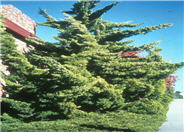
Common name:Hollywood Twisted Juniper
Botanical name:Juniperus chinensis 'Kaizuka'
This wild-looking tree will give an artistic Japanese accent to any setting. It has an upright habit which includes broad, shrubby branches that spread irregularly but gracefully. Junipers are highly combustible plants.
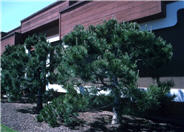
Common name:Japanese Black Pine
Botanical name:Pinus thunbergii
This variety of Pine is both rigid and twisted, with needles of 3"-4". It has an irregular shape, and the short, contorted branches produce a canopy shaped tree. The buds are white, and the cones are egg -shaped and without prickles. Pines are highly combustible plants.
Using Water Wisely
An efficient watering system applies the right amount of water to the right parts of the garden at the right time. This conserves water and saves you money.
Click in the green box for more information
| Designer: Homeowner | Thyme and Friends |
Photographer: GardenSoft |
Soils and Compost:
Practice grass-cycling by leaving short grass clippings on lawns after mowing, so that nutrients and organic matter are returned to the soil.
Integrated Pest Management:
Remove irrigation water and fertilizer from areas where you don't want weeds to grow.

